- Details
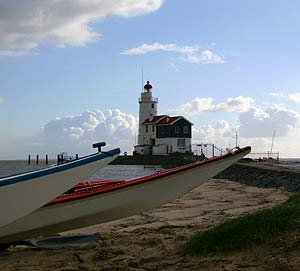
Today it felt about time for paddling some big water again. Apart from Hans (You can click this link for his report about our trip) and me, nobody else was available or was in the mood. As the weatherforecast did not say anything about a summersday, we went to the IJsselmeer, a relatively sheltered place, and planned Muiden-Marken vv., paddling both our AnasAcuta´s.
Early in the morning the black skies predicted heavy weather, but when we shove our kayaks into the water, the wind died and the skies lifted.
Apart from the cold wind this was a good day for paddling; a real "weather window" in between days of storm and expected rain. I enjoyed the skies and the sight of Hans' AnasAcuta dancing the waves.
- Details
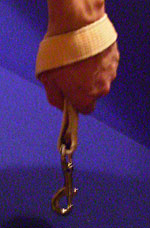 Did you ever have the feeling that seakaying is fine but that carrying the kayaks afterwards is a torment?
Did you ever have the feeling that seakaying is fine but that carrying the kayaks afterwards is a torment?
- Details
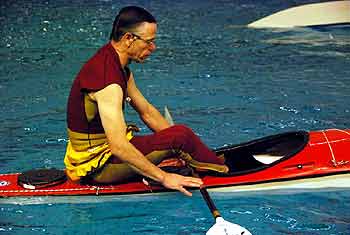
Last week Hans made a complete set of pictures in the swimmingpool from an action in which I tried to stand up on the aft deck.
He sent me the whole set, knowing I like to animate these kind of actions. Thx Hans.
- Details
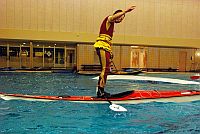
Photo by Hans Heupink. THX!
As Hans already wrote in his blog the four of us (Hans, Axel, Patrick and myself) were pool-playing on saterday-evening.
Always very good to practice the known techniques: just to keep in shape. And also to try and practice other techniques like the balance brace. Techniques to improve yourself.
Club members are asking me sometimes: Why the balance brace? What´s the purpose when out at sea?
Well, In a way they are right asking this themselves, because when there are waves I guess your head will be more under than above the water level in this brace.
- Details
A site-counter is an interesting tool from which you can learn a lot. It can also keep you motivated seeing the number of visitors.
So what can I learn from 2007 (minus week 52) ?
Well, first a continuing stream of almost 12.000 visitors bringing 480 pageviews each week (you should note that only about 10% of my pages has a counter, so probably the number of pageviews by these 12.000 visitors is much more)
It is not surprizing that most of the visitors come from the Netherlands, but since I write in English the other countries are increases.
- Details
Anoushka took the initiative organizing to go kayaking in surf this sunday: There were 3 of us.
As it was blowing quite a bit yesterday, there were enough waves. AND ![]() the weather was just perfect : with sunshine such a winterly exercise is not so grim. Starting around 12.00h the low tide just past away leaving fairly steep waves at the sandridge along the coast. The waves, some of them being 1,5 meter, just dumped on top of you. But as the tide rose again the waves became longer allowing some exiting rides.
the weather was just perfect : with sunshine such a winterly exercise is not so grim. Starting around 12.00h the low tide just past away leaving fairly steep waves at the sandridge along the coast. The waves, some of them being 1,5 meter, just dumped on top of you. But as the tide rose again the waves became longer allowing some exiting rides.
- Details
BBC-news and the MCA reported last saterday about a competition on Strangford Lough (Ireland).
On saterday a kayakrace-event with 120 kayakers was planned.
As the weather was predicted to turn to bad conditions, it did make sens that a number of rescue boats were planned. However as most boats were broken down there remained only one to guide the 120 kayakers.
In the discussion following on the forum "UK rivers guidebook-sea&surf" some voices were saying that, with the predicted bad weather and with only one rescueboat at hand, the race should have been cancelled on forehand . Wich was done in the end anyway.
I think that makes sense and it´s clear that an organisation and/or leader can also make mistakes or a wrong judgement of the situation.
So best is to be alert, watch the leader or organisation and: also make your own judgement, based on your own skills. Never trust anyone completely where it concerns your own safety.
Anyway, underneath you find the report of the coastguard (MCA).
- Details
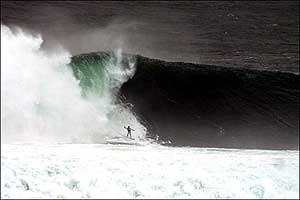
Last weekend it was not the best weather to go paddling. However: for some people this was an opportunity for THE ultimate challenge.
Honoustly, although I love waves, I do not dare to think about finding myself in waves likes this.
BBC News wrote on Saturday, 1 December 2007, 17:38 GMT:
- Details
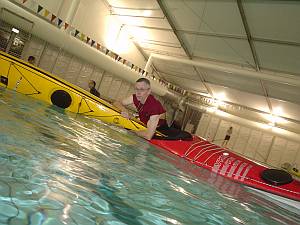
Hans invited me for saterday-evening to try and exersize the bowrollrescue in the swimmingpool.
As I was on the run during the whole saterday, Hans was so kind to take one of his own kayaks with him: for me to paddle in. Thx.Hans
After a short "rolling warming-up" we started to try the rescue. First on an empty kayak which was (too) easy!?
- Details
Having written yesterday about how to prevent hypothermia when paddling in surf, I realize now there is also another side of this story:
When one of your buddy's exited from the kayak and is swimming, not able to do a re-entry, he or she MUST get help to arrive as fast as possible to shore again!
Having heard a story that someone has to swim for 10 minutes to reach shore, OK - with 2 kayaks nearby but being bone-cold at the end and not being able to paddle anymore that day, I thought this was not the safest, best approach of the helpers.
